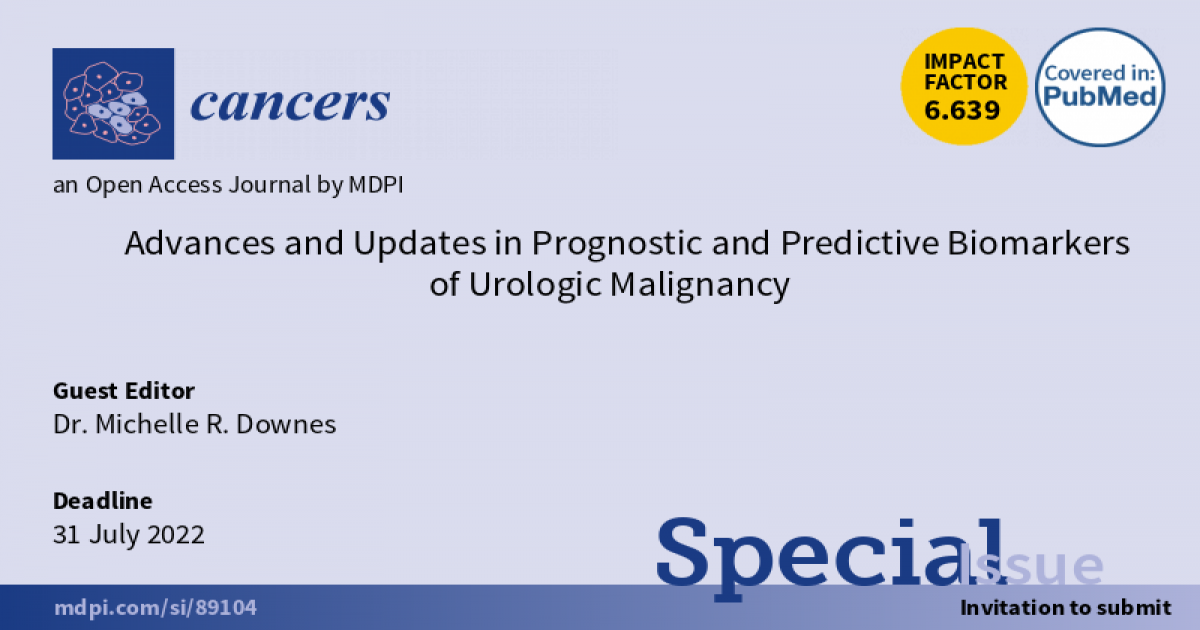- 4.4Impact Factor
- 8.8CiteScore
- 21 daysTime to First Decision
Advances and Updates in Prognostic and Predictive Biomarkers of Urologic Malignancy
This special issue belongs to the section “Cancer Biomarkers“.
Special Issue Information
Dear Colleagues,
The last decade has seen an unprecedented growth in knowledge of, and therapeutic options for, urologic malignancies. The publication of The Cancer Genome Atlas (TCGA) along with increased access to molecular techniques has resulted in an improved understanding of disease biology across a range of urologic cancers. In tandem with this, the emergence of immuno-oncology along with novel targeted therapies has expanded the spectrum of management options beyond surgery, radiation and traditional chemotherapy. These novel treatment strategies necessitate some form of biomarker assessment (morphologic markers, molecular/OMIC markers, radiology features, liquid markers) to determine eligibility for treatment, treatment response and monitoring of disease progression. At present, hereditary and somatic biomarkers have become crucial components of the clinical decision framework.
The aim of this Special Issue is to provide a comprehensive overview of the state of prognostic and predictive biomarkers of urologic malignancy. Original research papers and systematic reviews related to all aspects of biomarkers of urologic cancers are welcomed.
Dr. Michelle R. Downes
Guest Editor
Manuscript Submission Information
Manuscripts should be submitted online at www.mdpi.com by registering and logging in to this website. Once you are registered, click here to go to the submission form. Manuscripts can be submitted until the deadline. All submissions that pass pre-check are peer-reviewed. Accepted papers will be published continuously in the journal (as soon as accepted) and will be listed together on the special issue website. Research articles, review articles as well as communications are invited. For planned papers, a title and short abstract (about 250 words) can be sent to the Editorial Office for assessment.
Submitted manuscripts should not have been published previously, nor be under consideration for publication elsewhere (except conference proceedings papers). All manuscripts are thoroughly refereed through a single-blind peer-review process. A guide for authors and other relevant information for submission of manuscripts is available on the Instructions for Authors page. Cancers is an international peer-reviewed open access semimonthly journal published by MDPI.
Please visit the Instructions for Authors page before submitting a manuscript. The Article Processing Charge (APC) for publication in this open access journal is 2900 CHF (Swiss Francs). Submitted papers should be well formatted and use good English. Authors may use MDPI's English editing service prior to publication or during author revisions.
Keywords
- prostate
- bladder
- kidney
- urologic
- biomarkers
- prognosis
- predictive
- molecular

Benefits of Publishing in a Special Issue
- Ease of navigation: Grouping papers by topic helps scholars navigate broad scope journals more efficiently.
- Greater discoverability: Special Issues support the reach and impact of scientific research. Articles in Special Issues are more discoverable and cited more frequently.
- Expansion of research network: Special Issues facilitate connections among authors, fostering scientific collaborations.
- External promotion: Articles in Special Issues are often promoted through the journal's social media, increasing their visibility.
- e-Book format: Special Issues with more than 10 articles can be published as dedicated e-books, ensuring wide and rapid dissemination.

